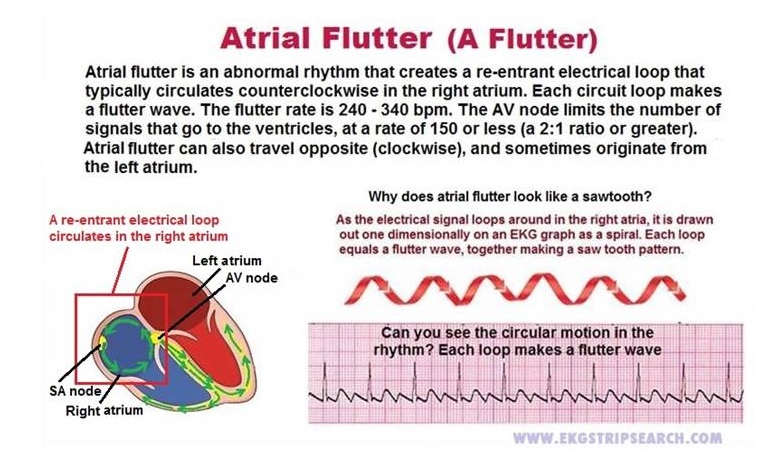 Type I and type II atrial flutter: Type I atrial flutter, also known as typical atrial flutter, is located in the right atria. Type I flutter is further divided into two subtypes depending on the direction the current is passing through the loop, 1. counterclockwise (most common) and 2. clockwise atrial flutter. Both have an atrial rate of 240 to 340 bpm. Type II flutter (atypical a-flutter) originates from the left atrium which is far more rare. It follows a significantly different re-entry pathway than type I flutter, and is typically faster, usually 340-440 bpm. You might find Left atrial flutter after incomplete left atrial ablation procedures. The main danger of atrial flutter is that the heart does not pump blood very well when it is beating too fast. Vital organs such as the heart muscle and brain may not get enough blood. Because the lack of effective contractions from the atria, there may be stasis (pooling) of blood in the atria. This may lead to formation of thrombus (blood clots) within the heart. Thrombus is most likely to form in the atrial appendages. Thrombus in the left atrial appendage is particularly important since the left side of the heart supplies blood to the entire body. Thus, any thrombus material that dislodges from this side of the heart can embolize to the brain with the potentially devastating consequence of a stroke. Thrombus material can embolize to any other portion of the body, though usually with a less severe outcome. Risk Factors for developing atrial Flutter
It is possible that many people may feel no symptoms at all. Those who do experience symptoms, may include:
Complications of Atrial Flutter A-flutter itself is not life threatening. If left untreated, the side effects of a-flutter can be potentially life threatening. AFL makes it harder for the heart to pump blood effectively. With the blood moving more slowly, it is more likely to form clots. If the clot is pumped out of the heart, it could travel to the brain and lead to a stroke or heart attack. Without treatment, a-flutter can also cause a fast pulse rate for long periods of time. This means that the ventricles are beating too fast. This can lead to cardiomyopathy, which can lead to heart failure and long-term disability. A-flutter can also degrade into atrial fibrillation (AFib). |
Return to Home Page
